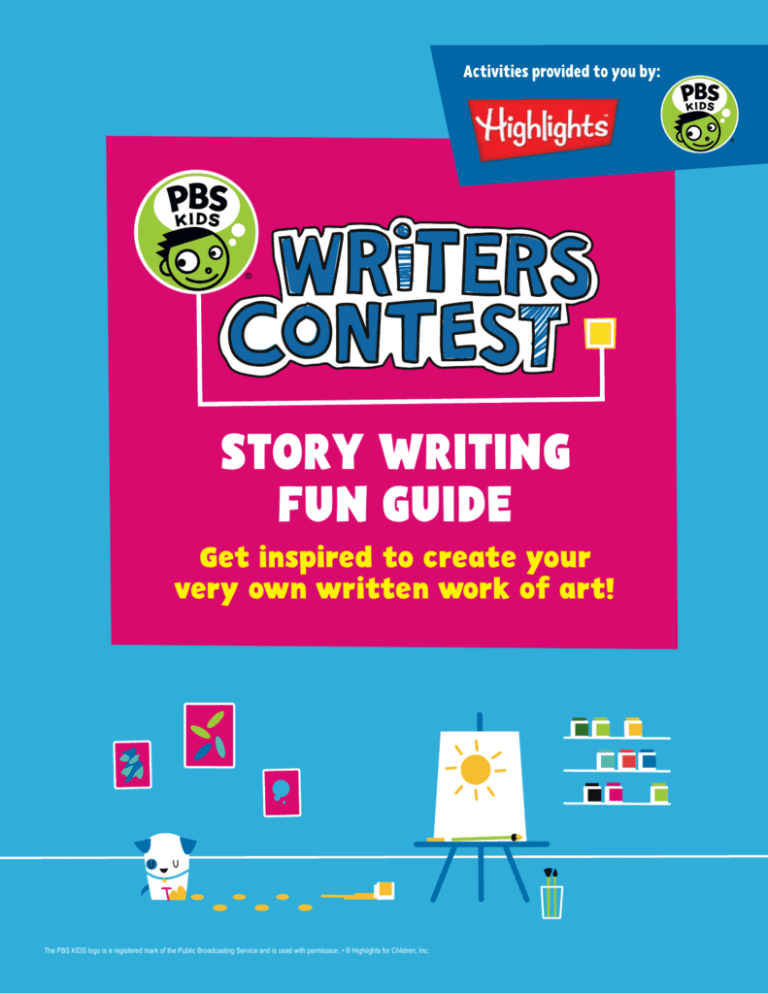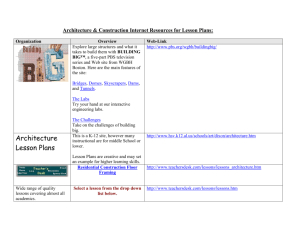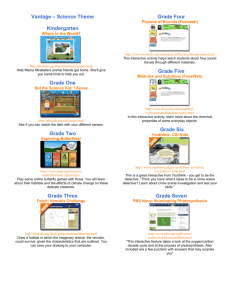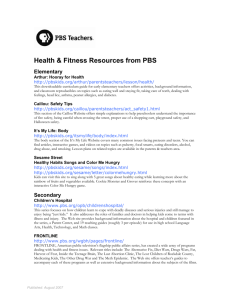
Activities provided to you by:
STORY WRITING
FUN GUIDE
Get inspired to create your
very own written work of art!
The PBS KIDS logo is a registered mark of the Public Broadcasting Service and is used with permission. • © Highlights for Children, Inc.
GREAT STORY!
Brainstorming Activity
Use these activity pages to start your story.
Write down or draw whatever ideas you have.
Story Structure All stories have a beginning, middle and an end.
Write down or draw how you want the story to start, what happens during the story, and how will it end.
Beginning
Middle
End
Activities provided to you by:
For more information and how to enter visit:
pbskids.org/read
The Cat In The Hat Knows A Lot About That! TM & © 2014 Dr. Seuss Enterprises, L.P. All rights reserved. • © Scholastic Entertainment Inc. WORDGIRL is a registered trademark
of Scholastic Inc. All rights reserved. • The PBS KIDS logo is a registered mark of the Public Broadcasting Service and is used with permission. • © Highlights for Children, Inc.
BRAINSTORMING
is a way to come up with
new and different ideas.
Use those ideas to write a
Main Character The person, animal or thing that
your story is about. Create a list of different characters you want in your story
and describe them. (Spike the dog is fluffy, Aunt Sally always wears funny clothes.)
Setting
Description
Where your story takes place.
Create a list of different places (the zoo, the moon) and choose whether it’s the past, present or future
(last year, next Tuesday). Think about how the setting might affect your character (the snow made it cold).
Setting
Activities provided to you by:
For more information and how to enter visit:
pbskids.org/read
© 2014 WGBH Educational Foundation. TM © “Martha” and underlying artwork: Susan Meddaugh. • © Scholastic Entertainment Inc. WORDGIRL is a registered trademark of Scholastic Inc. All rights reserved.
The PBS KIDS logo is a registered mark of the Public Broadcasting Service and is used with permission. • © Highlights for Children, Inc.
Character
Problem & Resolution
The challenge your
character(s) face and how they overcome it.
Create a list of problems (passing a math quiz, fighting an evil villain). Then in a separate list
create ways to solve the problem. Choose your favorite scenarios and circle them.
Resolution
All that brainstorming
has paid off! You now
have a basic plan.
Turn the page over
and use the space
to start your story.
Have fun!
Activities provided to you by:
For more information and how to enter visit:
pbskids.org/read
Arthur character registered trademark and © 2014 Marc Brown. WGBH/Cookie Jar Entertainment Inc. The Cat In The Hat Knows A Lot About That! TM & © 2014 Dr. Seuss Enterprises, L.P. All rights reserved.
The PBS KIDS logo is a registered mark of the Public Broadcasting Service and is used with permission. • © Highlights for Children, Inc.
Problem
Story running long?
Grab another sheet of paper!
Activities provided to you by:
For more information and how to enter visit:
pbskids.org/read
Arthur character registered trademark and © 2014 Marc Brown. WGBH/Cookie Jar Entertainment Inc. • © 2014 WGBH Educational Foundation. TM © “Martha” and underlying artwork: Susan Meddaugh.
The PBS KIDS logo is a registered mark of the Public Broadcasting Service and is used with permission. • © Highlights for Children, Inc.
Let the story writing begin!
Use this space to write your story
Write This! Write a caption for the picture below.
It’s a happy, sunny day!
Arthur character registered trademark and © 2014 Marc Brown. WGBH/Cookie Jar Entertainment Inc. • The PBS KIDS logo is a registered mark of the Public Broadcasting Service and is used with permission. • © Highlights for Children, Inc.
Then either draw your own or cut and paste pictures into the empty
boxes.Then write a caption for each picture.
(Write your own caption here.)
Activities provided to you by:
For more information and how to enter visit:
pbskids.org/read
Story Revision Checklist
Does my story have a beginning, middle, and end?
My story is organized!
Does my story answer my reader’s questions
about what happened?
My story is developed!
Does my story include enough information?
My story is detailed!
Does my story use clear and specific words?
My story has good vocabulary!
Do my sentences make sense when I read
them out loud?
My story has good
sentence structure!
Did I check my story for correct spelling,
punctuation, and capitalization?
My story is proofread!
Activities provided to you by:
For more information and how to enter visit:
pbskids.org/read
© 2014 Kratt Brothers Co/9 Story Entertainment. • © Scholastic Entertainment Inc. WORDGIRL is a registered trademark of Scholastic Inc. All rights reserved.
The PBS KIDS logo is a registered mark of the Public Broadcasting Service and is used with permission. • © Highlights for Children, Inc.
Read your story out loud. Then ask yourself each of these questions.
If the answer is yes, check it off on the checklist!
Play with these ideas, and get your
writing rolling! Art by Stacy Curtis
Character Rap
By Susan O. Morelli
Parody Play
By Beverly McLoughland
Rewrite a song from someone
else’s point of view. For example,
imagine “The Twelve Days of
Christmas” sung by a dog. What
gifts would the dog receive? We’ve
started the song below. Can you
finish it?
With a partner, decide on two characters who are going to have a
conversation. Maybe your characters will be Abraham Lincoln and
George Washington, Goldilocks and one of the three bears, or a lion
and hippo who both want to drink from the same watering hole.
One of you starts the conversation on paper, writing a sentence as
one of the characters. The other person writes a response as the second
character. Keep going, back and forth, until you have written for about
10 minutes. Then read your script like a
play, with each person reading his or her
character’s part.
On the first day of Christmas,
My human gave to me
A doghouse with a flat-screen TV.
Fable-Able
Photo Poems
By D.A. Woodliff
By Beverly McLoughland
Do you know the story “The Tortoise and the Hare,” with the lesson
“Slow and steady wins the race”? It was written more than 2,000 years
ago by Aesop, a Greek fable-teller, called a fabulist.
Now it’s your turn to be a fabulous fabulist! Write your own fable with
a moral or lesson, using animals as the characters. Will they include a
brave lion? A sly fox? A strong ox? A proud peacock? It’s up to you!
Write a poem that makes a
favorite photo come to life. Your
poem can be silly or thoughtful,
true-to-life or outrageous. If you
do this for a few photos, you can
make them into a book.
On the second day of Christmas,
My human gave to me
Two tasty bones and
A doghouse with a flat-screen TV.
Activities provided to you by:
For more information and how to enter visit:
pbskids.org/read
The PBS KIDS logo is a registered mark of the Public Broadcasting Service and is used with permission. • © Highlights for Children, Inc.
Write Now!
Fu n ny Fo l d - U ps
Get ready to laugh with these paper-passing games!
Hilarious Headlines
(for three or more people)
(for two or more people)
By Chelsea Ottman Rak
By Rosanne Lindsay
Give each person a sheet of
paper and a pencil.
Each player thinks up
an imaginary newspaper
headline and writes it at the
top of his or her paper.
Players pass the
papers to the person on
their right so that
everyone gets someone
else’s headline. Just
below the headline
players receive, they
draw a picture to
illustrate it, then fold
back the headline so
that just the picture
shows. Again, they pass
the papers to the right.
Players write a new headline to go with the
picture they receive, then fold back the picture
so that just the new headline
shows. They pass the papers
again.
Play continues until
everyone has written or
drawn on each paper.
Then unfold the papers
and share the silliness.
I learned this activity
from my Hungarian mother,
who learned it as a child.
She called it Kis Ember
(keesh EHM-behr), which is
Hungarian for “Little Man.”
Give each person a strip
of paper (about 3 inches by
11 inches) and markers.
Each player thinks of a
character, then draws the
character’s head and neck at the
top of his or her paper. The player
then folds back the paper, leaving
only the neck visible, and passes
the folded paper to the person on
the right.
Each player draws his or her
own character’s body, from neck to
waist, on the paper he or she has
received without looking at what
was drawn
before. Folding back the
paper to leave just the waist
visible, each player passes
the paper to the right.
Players continue drawing
one section of their character
at a time (waist to knees,
knees to feet), then folding
and passing the papers.
After the final pass, they
open the completed drawings
to reveal the mixed-up,
one-of-a-kind characters.
Art by David Helton.
Activities provided to you by:
For more information and how to enter visit:
pbskids.org/read
The PBS KIDS logo is a registered mark of the Public Broadcasting Service and is used with permission. • © Highlights for Children, Inc.
Character
Creations
p
S in
Art by Tom Nick Cocotos
Weave outrageous tales with
the help of a “story card” deck.
To Play
e Cards
To Make th
ission,
m
arent’s per
1. With a p
old
om
fr
s
ture
cut out pic
gs.
lo
ta
ca
and
magazines
an
to
on
re
pictu
2. Glue each
ast
. Make at le
index card
20 cards.
More
Ways to
Play!
Deal an equal number of cards
to each player. Each person keeps
his or her cards facedown in a pile.
The first person f lips over her top
card and begins a story by saying
something related to the picture.
For example, if the card shows a
parachute, she might say,
“Last summer, I went
parachuting for the first time
in my life. But suddenly . . .”
Spread the cards
faceup, and choose
one on each turn.
Player 2 then f lips the top card
in his pile to continue the story.
For example, if the card shows a
polar bear, he might say,
“The wind picked up, and I
was carried to the North
Pole. Luckily a polar bear was
out for a drive in his
convertible, and I landed in
the passenger seat.”
The next player f lips a card,
and on the story goes. The object
is to weave a tale for everyone to
enjoy.
When you’re finished with one
story, shuff le the cards and play
again!
Players get just
30 seconds per turn.
Make a deck with
verbs instead of
pictures.
Play charades with
the
deck. (Silently act
out
the picture while
others tr y to gues
s.)
Use cards as
idea-starters for
creating drawings
or poems.
Activities provided to you by:
For more information and how to enter visit:
pbskids.org/read
The PBS KIDS logo is a registered mark of the Public Broadcasting Service and is used with permission. • © Highlights for Children, Inc.
By Jean Kuhn
l
S
l
a i y S tory
You Finish the Story!
The Tale of the Five-Nosed Monster
A storm raged outside.
BA-BOOM!
Mindy and Jamal shuddered as
thunder shook their home.
“When are Mom and Dad coming
back?” asked Mindy.
“Soon,” said Jamal. “They’re just
checking on Mrs. Horn. Don’t worry.”
CRACK!
Art by Paula J. Becker.
For a fraction of a second,
lightning revealed a figure in the
living-room window. It looked just
like a monster with five noses.
Jamal gasped, and Mindy
screamed.
Just then . . .
What do you think will happen next?
Finish the story!
Activities provided to you by:
For more information and how to enter visit:
pbskids.org/read
The PBS KIDS logo is a registered mark of the Public Broadcasting Service and is used with permission. • © Highlights for Children, Inc.
We came up with this story beginning.
We want you to write an ending for it!





